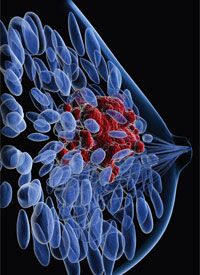- Advertise
- About OncLive
- Editorial Board
- MJH Life Sciences brands
- Contact Us
- Privacy
- Terms & Conditions
- Do Not Sell My Information
2 Clarke Drive
Suite 100
Cranbury, NJ 08512
© 2025 MJH Life Sciences™ and OncLive - Clinical Oncology News, Cancer Expert Insights. All rights reserved.
Individualized Adjuvant Endocrine Approach Appropriate in Breast Cancer
Ten-year results from the TEAM trial on exemestane alone and sequential treatment with tamoxifen followed by exemestane for postmenopausal women with hormone receptor-positive breast cancer showed they were reasonable treatment options.

Ten-year results from the TEAM trial showed that exemestane alone and sequential treatment with tamoxifen followed by exemestane are both “reasonable adjuvant treatment options” for postmenopausal women with hormone receptor-positive breast cancer.1
At a median follow-up of 9.8 years (IQR, 8.0-10.3), disease-free survival (DFS) was 67% (95% CI, 65-69) for the exemestane group and 67% (95% CI, 65-69) for the sequential group (hazard ratio [HR], 0.96; 0.88-1.05; P = 0.39). The treatment effect was consistent among all subgroups and investigators did not observe significant interaction between treatment and clinicopathological factors.
During follow-up, 30% of patients in the exemestane group (n = 3075) and 31% of patients in the sequential group (n = 3045) had a DFS event.
“Both the sequential scheme with tamoxifen followed by exemestane and exemestane monotherapy for 5 years are reasonable adjuvant treatment options for postmenopausal patients with hormone receptor—positive breast cancer, with no significant difference in survival after 10 years of median follow-up,” first author Marloes G M Derks, MD, Leiden University Medical Centre, the Netherlands, and coinvestigators wrote.
“This finding allows the possibility for shared decision making between the clinician and patient, balancing individual patient characteristics and preferences, side-effect profiles, and tolerability. Future studies will hopefully show which subgroup, if any, benefits more from a particular strategy, and whether extension of any of these treatments beyond 5 years is worthwhile,” added Derks et al.
Initiated in 2001, the phase III Tamoxifen Exemestane Adjuvant Multinational (TEAM) is a multinational, randomized, open-label trial. Postmenopausal women with histologically-confirmed breast adenocarcinoma and locally assessed estrogen receptor—positive or progesterone receptor–positive disease who had completed local treatment with curative intent were enrolled at 566 hospitals in 9 countries. Patients were assigned to 5 years of exemestane or a sequential scheme of 2.5 years of tamoxifen followed by 2.5 years of exemestane.
Patients assigned to tamoxifen were switched after 2.5 to 3.0 years to exemestane therapy for a total duration of 5.0 years of treatment. Dose reductions were not allowed.
In results published after a median of 5 years of follow-up, investigators found no significant difference in DFS, overall survival (OS), or relapse-free survival between the 2 treatment groups.
In this analysis, published in The Lancet Oncology, all patients from Japan (n = 184), France (n = 1230), and the United States (n = 2232) were excluded due to the absence of long-term data.
Twenty-four percent of patients in both groups died during follow-up, and 10-year OS was nearly identical: 74% (95% CI, 72-75) in the exemestane group versus 73% (95% CI, 72-75) in the sequential group (HR, 0.98; 95% CI, 0.89-1.09; P = .74).
Breast cancer recurrence occurred in 18% of patients in the exemestane group and 20% of patients in the sequential group. Cumulative incidence of breast cancer recurrence after 10 years of follow-up was lower in the exemestane group, at 20% versus 22% (subdistribution HR for recurrence-free interval, 0.88; 95% CI, 0.79-0.99; P = .03).
In the exemestane group, 15% of patients experienced distant recurrence compared with 16% patients in the sequential group. There was no difference in cumulative incidence of distant recurrence between the 2 arms: 16%, (95% CI, 15-18) in the exemestane group versus 18%, (95% CI, 16-19) in the sequential group. HR for distant recurrence-free interval was 0.91 (95% CI, 0.80-1.03; P = .15).
In the exemestane group, 12% percent of patients died of breast cancer compared with 14% in the sequential group. Cumulative incidence of breast cancer—specific mortality after 10 years of follow-up was 13.5% (95% CI, 12.3-14.9) in the exemestane group and 15.4% (13.0-16.9) in the sequential group (subdistribution HR, 0.88; 95% CI, 0.77-1.01; P = .07).
Among patients in the exemestane group, 12% died of causes other than breast cancer compared with 10% in the sequential group. Cumulative incidence for other-cause mortality was 12.8% in the exemestane group and 11.3% in the sequential group (subdistribution HR, 1.14; 95% CI, 1.00-1.31; P = .08). There were no significant differences for cause of death between the treatment groups (P = .321).
“The TEAM study teaches us several things,” Miguel Martin, MD, PhD, head of the medical oncology service at the Hospital General Universitario Gregorio Marañón in Madrid, wrote in an accompanying editorial.2 “First, when deciding between tamoxifen followed by exemestane and exemestane alone as adjuvant endocrine therapy, there is a trade-off between toxic effects and efficacy resulting in very similar survival outcomes with both strategies. Second, the authors confirm that patients with hormone receptor—positive breast cancer continue relapsing over time despite current endocrine therapies. The relapse incidence of 10% at 5 years and 20% at 10 years in the TEAM trial (similar to those noted in the BIG 1-98 trial) are too high to be deemed a good result, especially considering that the populations included in these trials were not at high-risk of relapse (about 50% were node-negative patients).
“We need better hormonal adjuvant approaches, particularly for high-risk groups. In the meantime, and while awaiting the results of these trials, either an aromatase inhibitor or the sequence of an aromatase inhibitor and tamoxifen are reasonable adjuvant endocrine options for postmenopausal patients with operable, hormone receptor—positive breast cancer.”
References
- Derks MGM, Blok EJ, Seynaeve C, et al. Adjuvant tamoxifen and exemestane in women with postmenopausal early breast cancer (TEAM): 10-year follow-up of a multicentre, open-label, randomised, phase 3 trial. Lancet Oncol. 2017;18(9):1211-1220. doi: 10.1016/S1470-2045(17)30419-9.
- Martin M. Tuning up adjuvant endocrine therapy: the TEAM trial. Lancet Oncol. 2017;18(9):1145-1146. doi: 10.1016/S1470-2045(17)30462-X.

